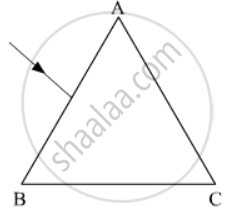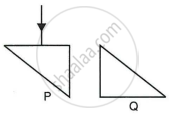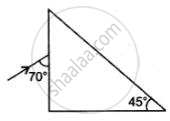Advertisements
Advertisements
प्रश्न
A spherical marble, of refractive index 1.5 and curvature 1.5 cm, contains a tiny air bubble at its centre. Where will it appear when seen from outside?
पर्याय
1 cm inside
at the centre
`5/3` cm inside
2 cm inside
उत्तर
`bb(5/3)` cm inside
Explanation:
The refractive index of the marble is 1.5.
One can see the image formed due to the reflection in the spheres.
In order to determine the distance where the image will form, use the lens maker formula.
Hence, `mu_1/v - mu_2/u = (mu_2 - mu_1)/"R"`
Where, refractive index of air = 1, refractive index of glass = 1.5, Radius of the curvature = 1.5 cm
Substituting the values, we get,
`therefore 1/v - 1.5/0.75 = (1 - 1.5)/1.5`
`therefore 1/v - 2 = - 0.5/1.5`
`therefore 1/v - 2 = - 1/3`
`therefore 1/v = - 1/3 + 2`
`therefore 1/v = (- 1 + 6)/3`
`therefore 1/v = 5/3`
Therefore, the tiny bubble will be seen 5/3 cm inside when we see it from the outside.
APPEARS IN
संबंधित प्रश्न
Name the factors affecting the critical angle for the pair of media.
The figure shows a ray of light falling normally on the face AB of an equilateral glass prism having refractive index`3/2`, placed in water of refractive index `4/3`.Will this ray suffer total internal reflection on striking the face AC? Justify your answer.

What is total internal reflection?
Two isosceles right-angle glass prisms P and Q are placed near each other as shown in Fig. Complete the path of the light ray entering the prism P till it emerges out of the prism Q.

Write the relation between the refractive index and critical angle for a given pair of optical media?
Swarali has got the following observations while doing an experiment. Answer her questions with the help of observations.
Swarali observed that the light bent away from the normal, while travelling from dense medium to rarer medium. When Swarali increased the values of angle of incidence (i), the values of angle of refraction (r) went on increasing. But at a certain angle of incidence, the light rays returned into the dense medium.
So, Swarali has some questions. Answer them –
a) Name this certain value of ‘i ’. What is the value of ‘r’ at that time ?
b) Name this process of returning of light in dense medium. Explain the process.
Define critical angle for a given medium.
Write down the relationship between the critical angle and the refractive index of the medium.
Draw a diagram, properly labelled, to illustrate the use of a total reflecting prism (a right-angled isosceles prism) to turn a ray of light through 180°. Name an instrument in which this device is used.
Complete the following diagram to show the path of the ray of a single colour in the diagram as if enters in and emerges out of the prism. Mark the angles wherever necessary. (Critical angle for glass = 42°).

Answer the following question.
Explain ‘mirage’ as an illustration of refraction.
Answer the following question.
Describe the construction and working of an optical fibre.
Answer the following question.
Why is prism binoculars preferred over traditional binoculars? Describe its working in brief.
The resultant `vec"R"` of `vec"P"` and `vec"Q"` is perpendicular to `vec"P"`. Also `|vec"P"|=|vec"R"|`. The angle between `vec"P"` and `vec"Q"` is ______.
[tan 45° = 1]
For the same angle of incidence, the angle of refraction in four media A, B, C and D are 25°, 30°, 35° and 40° respectively. The speed of light is least in medium ______.
For total internal reflection to take place, the angle of inddence i and the refractive index µ of the medium must satisfy the inequality ____________.
For a ray of light, the critical angle is minimum when it travels from ______.
A bundle of glass threads, each of which is capable of transmitting messages using light waves is called ______.
What is a mirage? How does it occur?
What is the phenomenon used in optical fiber? Explain.
What are the examples of total internal reflection in nature?
A ray of light passes from vacuum into a medium of refractive index µ, the angle of incidence is found to be twice the angle of refraction. Then the angle of incidence is ______.
Find the value of θ in the given figure.

Small air bubbles rising up a fish tank appear silvery when viewed from some particular angle is due to the ______.
